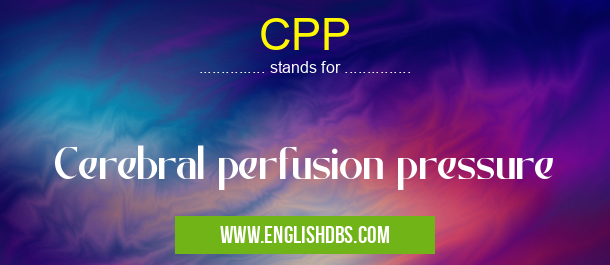What does CPP mean in CLINICAL MEDICINE
Cerebral perfusion pressure (CPP) is a key indicator of brain health and function. It is calculated as the difference between mean arterial pressure (MAP) and intracranial pressure (ICP). Maintaining optimal CPP is crucial for ensuring adequate blood flow to the brain and preventing neurological damage.

CPP meaning in Clinical Medicine in Medical
CPP mostly used in an acronym Clinical Medicine in Category Medical that means Cerebral perfusion pressure
Shorthand: CPP,
Full Form: Cerebral perfusion pressure
For more information of "Cerebral perfusion pressure", see the section below.
CPP Meaning in Medical
- CPP = MAP - ICP
Full Form of CPP
Cerebral Perfusion Pressure
Understanding CPP
- Mean arterial pressure (MAP): It represents the average pressure in the arteries over a cardiac cycle.
- Intracranial pressure (ICP): It measures the pressure within the skull and brain tissue.
Optimal CPP Range
The optimal range for CPP varies based on individual factors but generally falls between:
- 60-80 mmHg: For adults
- 50-70 mmHg: For children
Clinical Significance
CPP is a vital parameter in neurocritical care, as both high and low CPP can lead to adverse outcomes:
- High CPP (CPP > 80 mmHg): Increased risk of cerebral edema, bleeding, and herniation.
- Low CPP (CPP < 60 mmHg): Reduced cerebral blood flow, ischemia, and neurological dysfunction.
Essential Questions and Answers on Cerebral perfusion pressure in "MEDICAL»CLINICAL"
What is cerebral perfusion pressure (CPP)?
CPP is the force that drives blood flow to the brain. It is calculated by subtracting the intracranial pressure (ICP) from the mean arterial pressure (MAP). A normal CPP is between 60 and 100 mmHg.
Why is CPP important?
CPP is important because it ensures that the brain receives enough blood to function properly. If CPP is too low, the brain can become ischemic, which can lead to brain damage or stroke. If CPP is too high, it can cause cerebral edema, which can also damage the brain.
What are the symptoms of low CPP?
Symptoms of low CPP include confusion, lethargy, seizures, and coma. In severe cases, low CPP can be fatal.
What are the symptoms of high CPP?
Symptoms of high CPP include headache, nausea, vomiting, and vision changes. In severe cases, high CPP can lead to cerebral edema, which can be fatal.
How is CPP measured?
CPP can be measured using a variety of methods, including the invasive ICP monitor and the non-invasive transcranial Doppler (TCD) ultrasound. The ICP monitor is inserted into the brain through a small hole in the skull. The TCD ultrasound uses sound waves to measure blood flow in the brain's arteries.
How is CPP treated?
Treatment for low CPP depends on the underlying cause. Treatment for high CPP includes medications to lower blood pressure and ICP, and surgery to relieve pressure on the brain.
Final Words: Cerebral perfusion pressure (CPP) is a critical measure that reflects the balance between cerebral blood flow and intracranial pressure. Optimal CPP is essential for maintaining neurological health, and deviations from this range can have significant clinical implications. Understanding CPP and its implications is crucial for healthcare professionals involved in the care of patients with neurological conditions.
CPP also stands for: |
|
| All stands for CPP |
